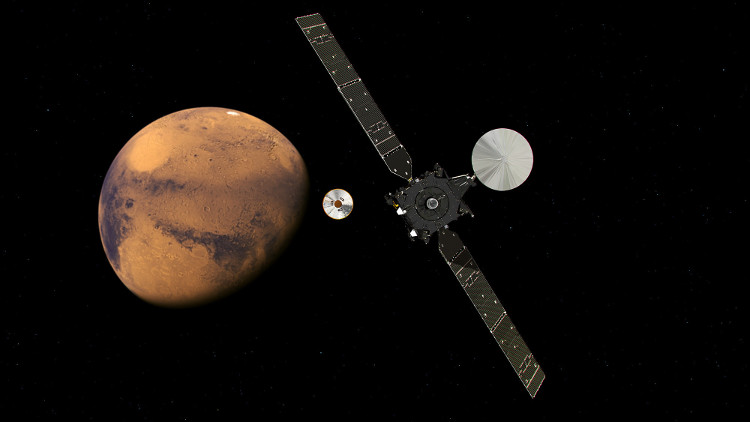Schiaparelli probes began the process of landing on Mars
On October 16, the European Space Agency (ESA) said the Schiaparelli amphibious module weighing nearly 600kg has begun the process of landing within 3 days on Mars.
After a seven-month journey to reach the Red Planet, Schiaparelli separated from the module "mother ship" TGO (Trace Gas orbiter) at 21:42 (Hanoi time) on October 16 and established the signal. with ground station.
According to the European Space Agency's (ESA) expert Jocelyne Landeau-Constantin, all have gone through the process after nearly an hour of engineers failing to get the signals of TGO. If everything goes according to plan, the Schiaparelli landing module will land on the Martian surface on October 19.
Flight Manager of the ExoMars 2016 project - Russian-European interplanetary station on Mars Michel Denis said the mother ship TGO must change its trajectory in the night to separate it from Mars, because otherwise the ship This will collide with the Earth. As expected, on October 19, TGO will fly into orbit Red planet.

Schiaparelli has separated from the TGO "mother ship" module.(Source: ESA).
Earlier, on March 14, the Russian Space Agency (Roscosmos) and the European Space Agency (ESA) launched the Russian-European planetary ExoMars station on Mars from Baikonur space airport in Kazakhstan by name. Proton-M boosts to explore this "Red planet". This is considered a significant contribution of European and Russian scientists in space research.
ExoMars is the first project that Russia and Europe work closely and deeply in the field of space. The main purpose of this cooperation is to find methane in the atmosphere on Mars to discover more about the origin of this gas on the Red planet.
According to the scientific world, methane can be generated on the basis of two different processes: geology and biology. Earlier, there were many documents suggesting that methane used to exist on Mars, and there was also a suggestion that this gas disappeared from the Martian atmosphere 100 years ago.
However, there are currently no documents showing that such processes have happened on Mars, especially without volcanic activity and no biological activity.
The ExoMars station put on the moduleTGO universe is responsible for analyzing the atmospheric composition of Mars in search of traces of methane and data delivery.

ExoMars is the first project that Russia and Europe work closely and deeply in the field of space.
The Schiaparelli module is responsible for validating the accuracy of research activities that European scientists have done. The results of those studies will allow another module in the ExoMars project to continue landing on Mars's surface by 2018, followed by other modules.
In 2013, Roscosmos and ESA agreed to collaborate on solar system research, especially the ExoMars Mars exploration project. Initially, Europe intended to implement this project with the US Aerospace Agency (NASA) but in 2012, the US side withdrew from the project because of insufficient facilities.
Therefore, Europe has asked Russia to take the US position with the use of two heavy Russian boosters to launch ExoMars.
- NASA announced the real picture of the landfall in the movie about Mars
- The NASA ship found robots landing on Mars
- Europe's Schiaparelli robot responds successfully to Mars
- Amphibious robots may have died on Mars because of opening soon
- Locate the answer for Europe's Mars mission
- A silly mistake in calculation made the Schiaparelli lander
- InSight probes successfully landed on the surface of Mars, a new era has just opened
- The NASA autonomous probe is about to land on Mars
- Mars is hotter than 0 ° C
- Europe will launch a spacecraft to Mars next week
- NASA landing gear gains strange pulses on Mars
- China successfully tested the Mars landing station
 Van Allen's belt and evidence that the Apollo 11 mission to the Moon was myth
Van Allen's belt and evidence that the Apollo 11 mission to the Moon was myth The levels of civilization in the universe (Kardashev scale)
The levels of civilization in the universe (Kardashev scale) Today Mars, the sun and the Earth are aligned
Today Mars, the sun and the Earth are aligned The Amazon owner announced a secret plan to build a space base for thousands of people
The Amazon owner announced a secret plan to build a space base for thousands of people